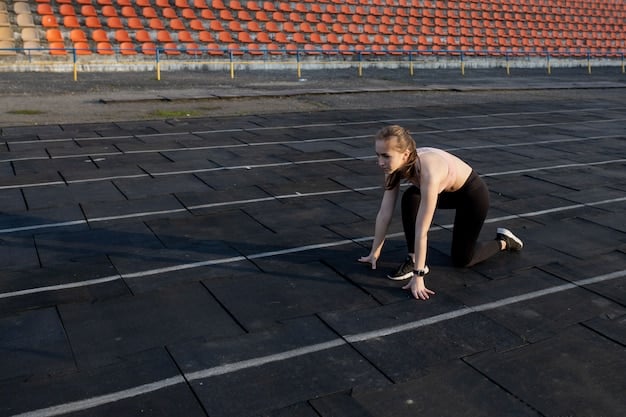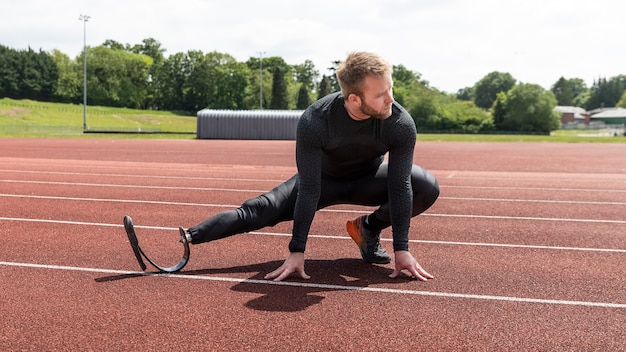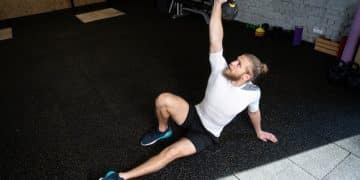Build Explosive Power: The Ultimate Plyometric Routine for Athletes

Achieving explosive power, crucial for athletic dominance across various sports, relies heavily on integrating a meticulously structured plyometric workout routine that optimizes muscular force production and reaction time without compromising joint integrity.
In the realm of athletic performance, the ability to generate rapid, powerful movements often distinguishes good from great. Developing Build Explosive Power: The Plyometric Workout Routine for Athletes is not merely about strength; it’s about how quickly and efficiently that strength can be deployed to propel, jump, or accelerate, making plyometrics an indispensable component of any serious athlete’s training regimen.
Understanding the Science of Explosive Power
Explosive power, in essence, is the rate at which an athlete can generate maximal force. It’s not just about how much weight you can lift, but how quickly you can move it. This critical athletic attribute is the cornerstone of success in sports ranging from basketball and football to track and field and martial arts.
The science behind explosive power development lies in the concept of the stretch-shortening cycle (SSC). This physiological phenomenon involves a rapid eccentric (muscle lengthening) contraction followed immediately by a forceful concentric (muscle shortening) contraction. Think of it like stretching a rubber band before releasing it—the pre-stretch allows for a more powerful subsequent contraction.
The Stretch-Shortening Cycle Explained
The SSC is fundamental to plyometric training. During the eccentric phase, muscles store elastic energy, which, if immediately followed by a concentric contraction, can be utilized to produce greater force than a stand-alone concentric contraction. This rapid transition is key to enhancing power output.
- Eccentric Phase: Muscle lengthens under tension, storing elastic energy.
- Amortization Phase: The brief, crucial period between eccentric and concentric contractions. A shorter amortization phase leads to greater power.
- Concentric Phase: Muscle shortens, releasing stored elastic energy and generating force.
Optimizing the amortization phase is paramount in plyometrics. The goal is to minimize the time between the eccentric and concentric actions, allowing for maximal utilization of the stored elastic energy. This is where the specific design of plyometric exercises comes into play.
Another crucial element is neuromuscular efficiency. Plyometrics train the nervous system to recruit muscle fibers more rapidly and synchronously, leading to faster and stronger contractions. This neurological adaptation is as important as the muscular gains in building explosive power.
In summary, harnessing explosive power involves a sophisticated interplay between muscular mechanics and neurological command. Plyometric training directly addresses both, making it an incredibly effective tool for athletes seeking a competitive edge.
Building Your Plyometric Foundation: Essential Warm-Up and Progression
Before launching into high-intensity plyometric drills, a comprehensive warm-up is non-negotiable. This isn’t just about preventing injuries; it’s about optimizing performance by preparing the neuromuscular system for maximal output. A proper warm-up increases core body temperature, improves blood flow to muscles, and enhances joint mobility.
The warm-up should transition from general aerobic activity to dynamic stretches and specific movement preparation. Begin with light cardio, followed by dynamic movements that mimic the actions of plyometrics, gradually increasing intensity and range of motion. This prepares muscles and connective tissues for the demands of explosive movements.
Dynamic Warm-Up Drills
- Leg Swings: Front-to-back and side-to-side swings to improve hip mobility.
- Arm Circles: Forward and backward circles to warm up the shoulders.
- Walking Lunges with Torso Twist: Engages the core and warms up the lower body.
- Carioca: Enhances lateral agility and hip rotation.
- High Knees and Butt Kicks: Activation drills that prepare the legs for powerful contractions.
Progression is the cornerstone of sustainable and effective plyometric training. Starting with basic drills and gradually increasing complexity, intensity, and volume is crucial to avoid injury and ensure continuous adaptation. Never jump into advanced exercises without a solid foundation.
Beginners should focus on low-impact, foundational plyometrics with proper technique. As strength, stability, and control improve, exercises can become more challenging, incorporating higher drops, greater distances, and single-leg variations. Listen to your body and prioritize quality over quantity.
It’s also important to consider the athlete’s current strength levels. Athletes should be able to squat at least 1.5 times their body weight for lower body plyometrics and bench press 1.0 times their body weight for upper body plyometrics. This ensures that the athlete’s muscles and joints can safely handle the forces generated during plyometric exercises.
Ultimately, a well-structured warm-up sets the stage for a productive plyometric session, while a thoughtful progression plan ensures long-term development of explosive power while minimizing injury risk.
Lower Body Dominance: Key Plyometric Exercises for Leg Power
The lower body is where much of an athlete’s explosive power originates, driving actions like jumping, sprinting, and directional changes. Plyometric exercises for the legs are therefore fundamental to improving an athlete’s performance. These drills focus on maximizing the output from the major muscle groups of the glutes, quadriceps, and hamstrings.
Effective lower body plyometrics demand precise technique to ensure maximum benefit and injury prevention. Focus on soft landings, quick transitions, and maximal effort on each repetition. The aim is to spend as little time on the ground as possible, minimizing the amortization phase.
Essential Lower Body Plyometrics
Here are some cornerstone exercises that form the backbone of a powerful lower body plyometric routine:
- Box Jumps: Stand facing a sturdy box. Explode upwards, landing softly on the box with both feet. Step down rather than jumping down to reduce impact.
- Broad Jumps: From a standing position, swing arms back, then explode forward and up, landing as far as possible. Focus on a controlled, soft landing.
- Depth Jumps: Step off a low box, landing softly, and immediately explode into a vertical jump. This intensifies the stretch-shortening cycle.
- Bounding: Exaggerated running strides with an emphasis on maximal horizontal propulsion and air time.
Beyond these foundational movements, variations can add complexity and challenge. Single-leg variations, such as single-leg hops or pistol box jumps, increase the demand on individual leg strength, stability, and balance, closely mimicking sport-specific movements.

The intensity and volume of lower body plyometrics should be carefully managed. Too little will not yield results, while too much can lead to overuse injuries. For most athletes, 2-3 sessions per week on non-consecutive days, with adequate rest between sets and exercises, is an effective starting point.
Remember that the quality of movement outweighs the quantity of repetitions. Each jump should be performed with maximum effort and concentration. As muscular endurance improves, the focus can shift towards maintaining high power output over multiple repetitions.
Integrating these powerful lower-body plyometrics into a training program will drastically enhance an athlete’s ability to explode, jump higher, run faster, and change direction more effectively, paving the way for superior on-field or court performance.
Upper Body and Core Explosiveness: Beyond Leg Day
While lower body power often takes center stage in plyometric discussions, upper body and core explosiveness are equally vital for diverse athletic movements. A strong, responsive upper body and a stable, powerful core contribute significantly to throwing, striking, pushing, and pulling actions, enhancing overall athletic prowess.
Upper body plyometrics focus on training the stretch-shortening cycle in the arms, shoulders, and chest. These exercises are crucial for athletes in sports requiring strong overhead movements, powerful throws, or explosive pushes, such as baseball, tennis, swimming, and boxing.
Developing Upper Body Power
- Medicine Ball Throws: Varied throws (overhead, chest pass, rotational) engage the entire upper body and core, mimicking sport-specific movements.
- Plyometric Push-Ups: Explosively push off the ground, aiming for hands to leave the floor. Advanced variations include claps or elevating the hands or feet.
- Plyo Ball Catches: Rapidly catch and immediately throw a heavy medicine ball, emphasizing quick absorption and re-direction of force.
The core serves as the bridge between the upper and lower body, transferring force and providing stability during dynamic movements. A strong and explosive core is essential for efficient movement patterns and injury prevention.
Core plyometrics are not about traditional crunches but about dynamic movements that train rotational power and stabilization under rapid force. These exercises often integrate full-body coordination, ensuring that power generated in the extremities can be effectively channeled through the core.
Core Plyometrics for Stability and Power
Exercises targeting core explosiveness include:
- Medicine Ball Slams: Lift a medicine ball overhead and forcefully slam it to the ground, engaging the entire core.
- Rotational Throws: Throwing a medicine ball with a powerful rotational movement from the hips, through the core, and out through the arms.
- Sledgehammer Swings: Using a sledgehammer to strike a tire, engaging the core, shoulders, and arms in a powerful, coordinated movement.
Incorporating a balance of upper body and core plyometrics alongside lower body drills ensures a holistic approach to developing explosive power. This comprehensive training regimen leads to a more well-rounded athlete, capable of unleashing power efficiently from any part of their body.
Remember to focus on controlled eccentric phases and swift, powerful concentric contractions for all plyometric exercises. Proper technique and consistent effort across all body regions will translate into significant improvements in overall athletic performance and resilience.
Integrating Plyometrics into Your Training Schedule: Periodization and Recovery
Successfully incorporating plyometrics into an athlete’s training schedule requires a strategic approach, considering periodization and emphasizing proper recovery. Simply adding plyometric drills without a well-thought-out plan can lead to overtraining, injury, and suboptimal performance gains.
Periodization, the systematic planning of athletic training, is crucial for maximizing benefits from plyometrics. It typically involves cycles of varying intensity and volume, allowing the body to adapt and build capacity. Plyometrics can be integrated into different phases of an athlete’s macrocycle.
Phases of Integration
- Off-Season/Preparatory Phase: Focus on foundational plyometrics with moderate volume and intensity, building a base of strength and technique. This is the time to build general athletic qualities.
- Pre-Season/Competitive Phase: Transition to more sport-specific, higher-intensity plyometrics with lower volume, aimed at peaking performance. Here, the goal is to convert general power into specific, on-field explosive movements.
- In-Season/Maintenance Phase: Minimal plyometrics, often a few sets of high-intensity drills once or twice a week, to maintain power without causing excessive fatigue or interfering with competition.
Recovery is perhaps the most overlooked yet critical component of any intense training program, especially plyometrics. The high-impact nature of these drills places significant stress on muscles, tendons, and joints. Adequate rest allows for repair, adaptation, and supercompensation.
Recovery is multi-faceted, encompassing rest, nutrition, and restorative practices. Insufficient recovery not only hinders performance but also significantly increases the risk of injury, negating the very purpose of plyometric training.
Key Recovery Strategies
- Adequate Sleep: Essential for muscle repair and hormone regulation. Aim for 7-9 hours per night.
- Nutrient-Rich Diet: Sufficient protein for muscle repair, carbohydrates for energy, and healthy fats for overall bodily function. Hydration is also paramount.
- Active Recovery: Light aerobic activity, stretching, foam rolling, and massage to promote blood flow and reduce muscle soreness.
- Rest Days: Schedule dedicated days off from intense training to allow the body to fully recover.

It’s important to program plyometrics on non-consecutive days, often with 48-72 hours of rest between sessions, especially for higher intensities. This ensures that the muscle fibers and nervous system have fully recovered and are ready for another high-quality training session. When combining with strength training, prioritize plyometrics when fresh, or schedule them on separate days.
By thoughtfully integrating plyometrics into a periodized training plan and prioritizing comprehensive recovery, athletes can safely and effectively harness the power-building benefits of these drills, leading to sustained performance improvements.
Common Mistakes to Avoid in Plyometric Training
While plyometrics offer significant benefits for athletic performance, improper execution or programming can lead to injuries or diminish effectiveness. Awareness of common pitfalls is crucial for any athlete embarking on or continuing with plyometric training.
One of the most frequent mistakes is neglecting proper warm-up and cool-down protocols. Skipping these essential steps leaves muscles and joints unprepared for the demands of explosive movements, vastly increasing the risk of strains, sprains, or more severe injuries.
Critical Errors in Plyometric Execution
- Insufficient Warm-Up: Directly jumping into high-intensity drills without proper physiological preparation.
- Ignoring Technique for Volume: Prioritizing the number of repetitions over the quality and precision of each movement.
- Inadequate Recovery: Not allowing sufficient rest between sets, exercises, or training sessions, leading to cumulative fatigue and burnout.
- Lack of Progressive Overload: Sticking to the same exercises and intensities without gradually increasing the challenge as the body adapts.
Another prevalent error is attempting exercises that are too advanced for one’s current readiness. Plyometrics are demanding, and attempting complex drills like high box jumps or depth jumps from excessive heights without a strong foundational base can result in poor form, falls, and injuries.
Athletes also sometimes fail to consider muscle imbalances. Focusing solely on a single plane of movement or neglecting antagonist muscles can create discrepancies in strength and stability, making the athlete more vulnerable to injury. A balanced approach is key.
The “more is better” mentality is particularly dangerous in plyometrics. Unlike strength training where progressive overload often means increasing weight, plyometrics are about quality, not quantity. Performing too many repetitions or too many sessions per week leads to overtraining and hinders the body’s ability to recover and adapt.
Finally, neglecting landing mechanics is a critical mistake. Every powerful jump must be followed by a controlled, cushioned landing. Absorbing forces effectively protects joints and allows for a quicker transition into the next movement. Crash landings are counterproductive and dangerous.
By understanding and actively avoiding these common mistakes, athletes can make their plyometric training safer, more effective, and a true catalyst for explosive power development, ultimately contributing to a more resilient and higher-performing athletic career.
Advanced Plyometric Drills and Sport-Specific Applications
Once a solid foundation in basic plyometrics is established and proper technique is mastered, athletes can progress to more advanced drills that closely mimic the specific demands of their sport. This progression ensures that the developed explosive power is directly transferable to on-field or on-court performance.
Advanced plyometrics often involve higher-intensity movements, single-leg variations, and multi-directional drills. These exercises challenge the neuromuscular system in a more complex manner, improving not only power but also agility, coordination, and reactive strength.
Examples of Advanced Drills
- Reactive Jumps: Rapid jumps immediately after landing from a drop or another jump, minimizing ground contact time.
- Single-Leg Bounding: Propelling forward or upward using only one leg, highly specific for sprinting and jumping sports.
- Ladder Drills with Explosive Finish: Combining quick footwork through an agility ladder with an immediate explosive sprint or jump.
- Plyometric Step-Ups: Explosively driving up onto a box from one leg, aiming for maximal height or speed.
The beauty of advanced plyometrics lies in their sport-specific application. For instance, basketball players might focus on continuous vertical jumps for rebounding, while soccer players could emphasize bounds and lateral jumps for rapid changes in direction and shot power.
Athletes in throwing sports can benefit from upper body rotational medicine ball throws that replicate the mechanics of their overhand throws, generating power from the ground up through the core to the arm. Sprinters, on the other hand, would focus heavily on bounding and sprint-specific plyometric drills to enhance stride length and frequency.
When implementing sport-specific plyometrics, it’s vital to ensure they align with the energy systems and movement patterns of the sport. The intensity and duration of the drills should mirror the bursts of activity experienced during competition.
Furthermore, resistance can be added carefully in some advanced drills to enhance power, such as wearing a weighted vest for box jumps (with very low additional weight) or using resistance bands for specific movements. However, this must be done with extreme caution to avoid compromising technique or increasing injury risk.
Ultimately, advanced plyometrics are about refining the ability to generate and apply explosive force in scenarios that closely simulate real game situations. This targeted training ensures that the gains made in the gym translate directly into a competitive advantage, allowing athletes to perform at their peak when it matters most.
| Key Aspect | Brief Description |
|---|---|
| 💪 Power Definition | Rate of force production, crucial for athletic movements like jumping and sprinting. |
| 🏋️ Core Plyos | Develops explosive strength in the torso, vital for throwing and rotational sports. |
| 🚶♂️ Progression | Start with foundational drills, gradually increasing intensity and complexity to avoid injury. |
| ⏱️ Recovery | Essential for muscle repair and adaptation; includes rest, nutrition, and active recovery. |
Frequently Asked Questions
▼
Explosive power is the ability to generate maximal force in the shortest amount of time. It’s crucial for athletes because it underpins fast, powerful movements like jumping, sprinting, throwing, and rapid changes in direction, directly impacting performance across almost all sports disciplines and contributing to competitive advantage.
▼
Plyometric training utilizes the stretch-shortening cycle (SSC) to enhance explosive power. It involves rapid eccentric muscle lengthening followed by an immediate, forceful concentric contraction, akin to stretching and releasing a rubber band. This strengthens muscles and trains the nervous system to react faster, leading to more powerful and efficient movements.
▼
While highly beneficial, plyometrics are intense and require a foundational level of strength and stability. Beginners should start with low-impact, foundational drills focusing on proper technique before progressing. It’s advisable to consult with a coach or trainer to ensure readiness and a safe progression to avoid injury and maximize benefits.
▼
For most athletes, 2-3 plyometric sessions per week on non-consecutive days are generally recommended, allowing for sufficient recovery (48-72 hours) between sessions. This frequency allows muscles and the nervous system to adapt and supercompensate without leading to overtraining or increased injury risk, ensuring sustained progress and performance.
▼
Common mistakes include insufficient warm-up, prioritizing volume over proper technique, inadequate recovery, and attempting drills that are too advanced. Neglecting proper landing mechanics and ignoring muscle imbalances are also significant errors. Avoiding these pitfalls is crucial for safe and effective plyometric training, preventing injury and maximizing results.
Conclusion
Developing explosive power through a well-structured plyometric workout routine is a game-changer for athletes aiming to elevate their performance across virtually any sport. By understanding the underlying scientific principles of the stretch-shortening cycle, building a solid foundation with proper warm-ups and progressive drills, and meticulously planning for adequate recovery, athletes can unlock their full athletic potential. Moving beyond generic routines to include both lower and upper body plyometrics, while carefully avoiding common pitfalls and integrating sport-specific applications, ensures that power gains translate directly into tangible competitive advantages. Embracing a disciplined and informed approach to plyometric training will undoubtedly set a new standard for athletic excellence.





